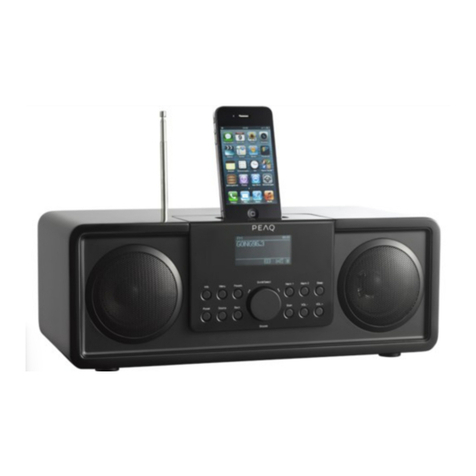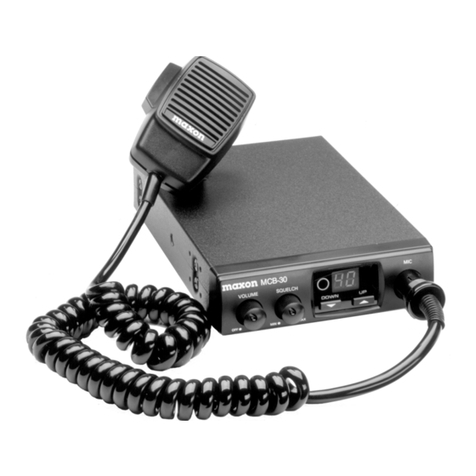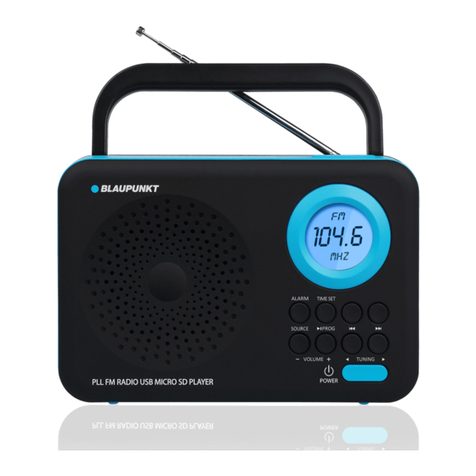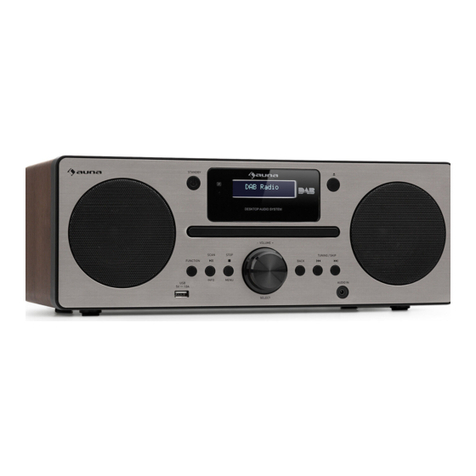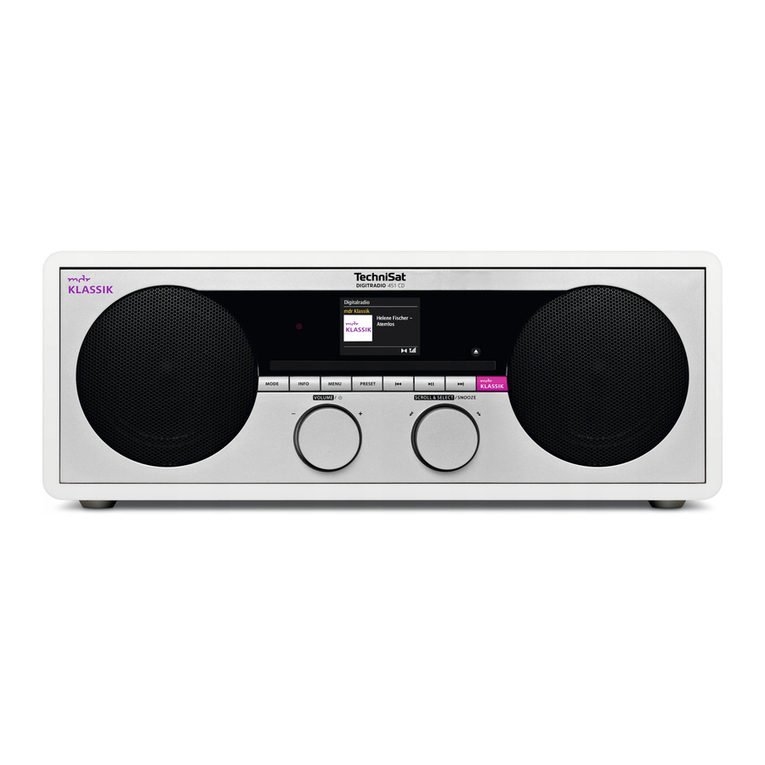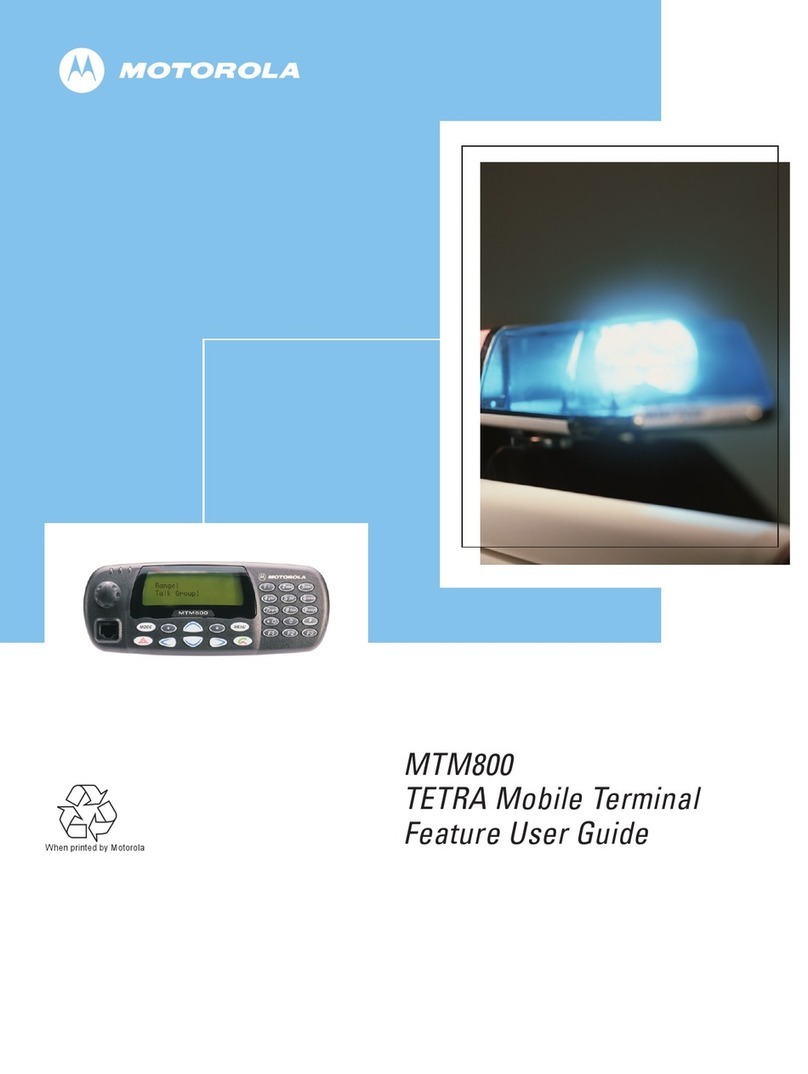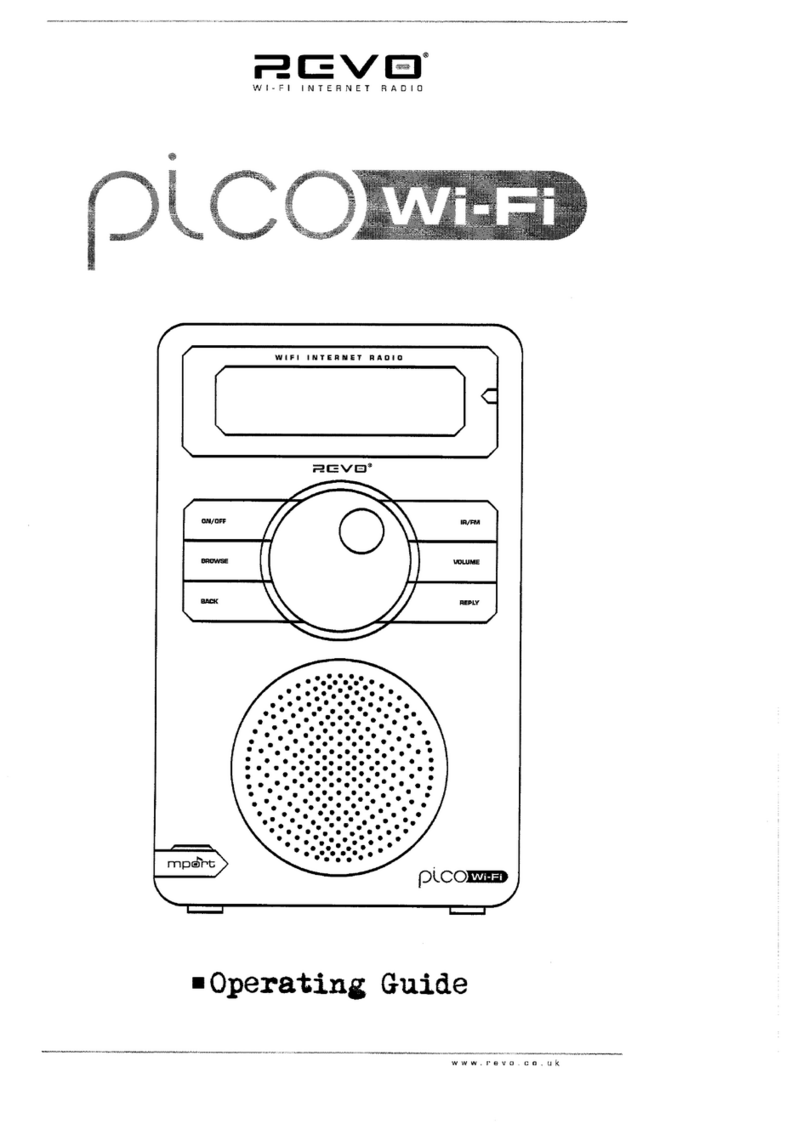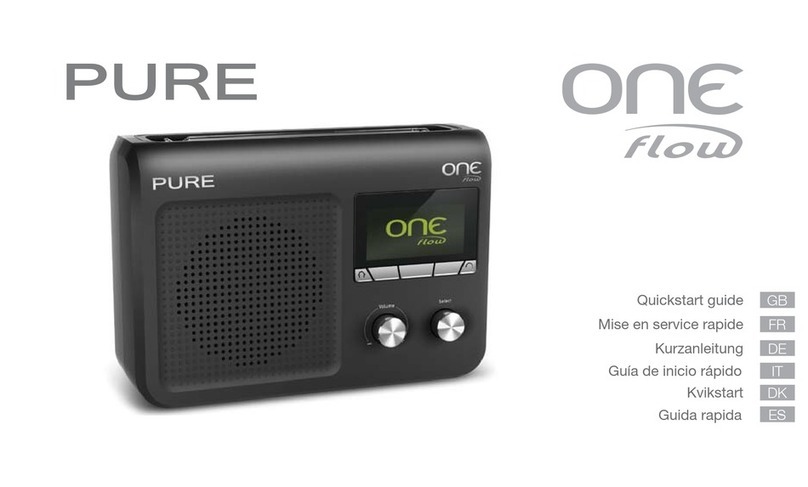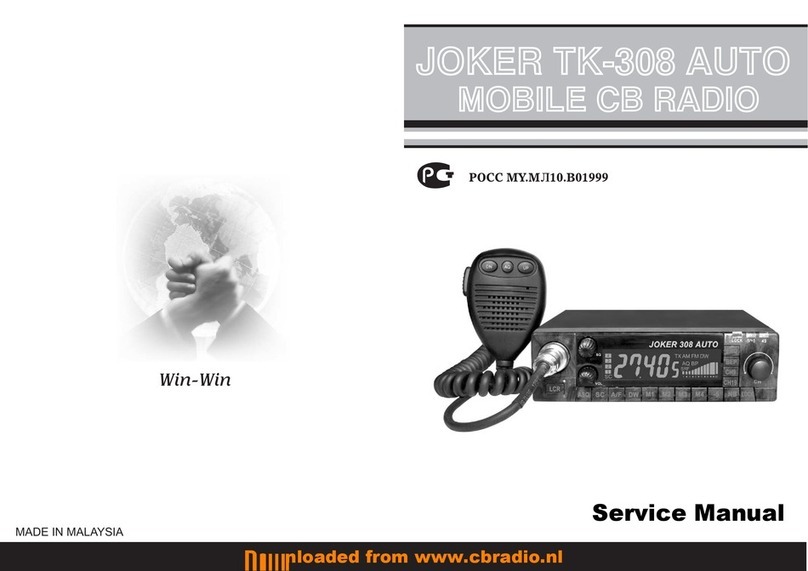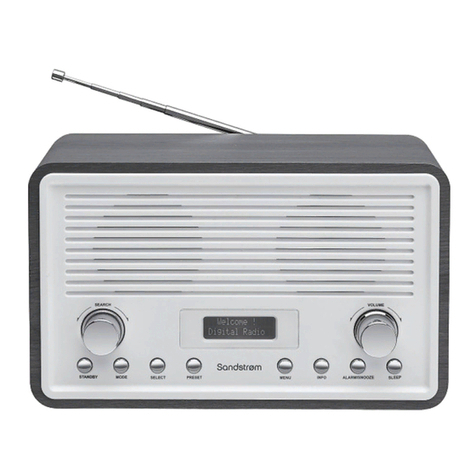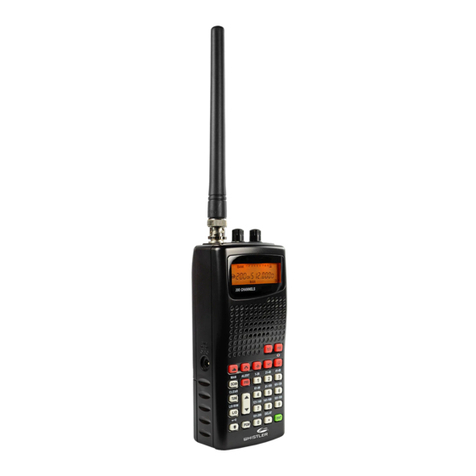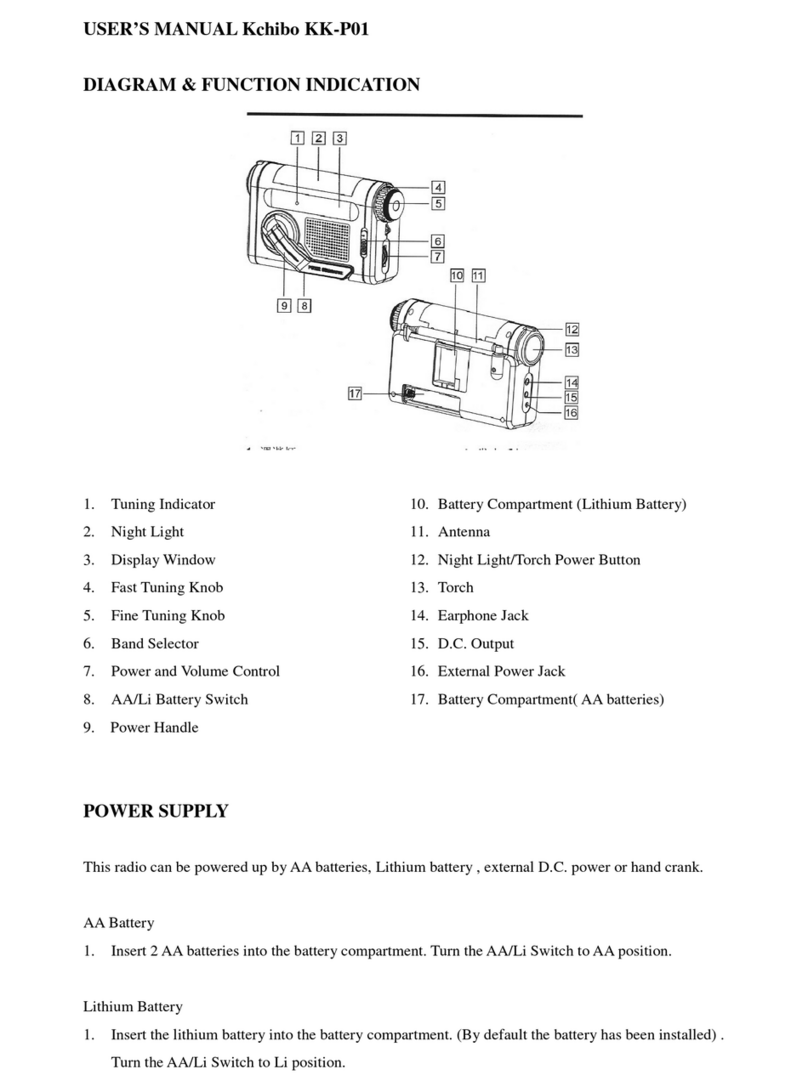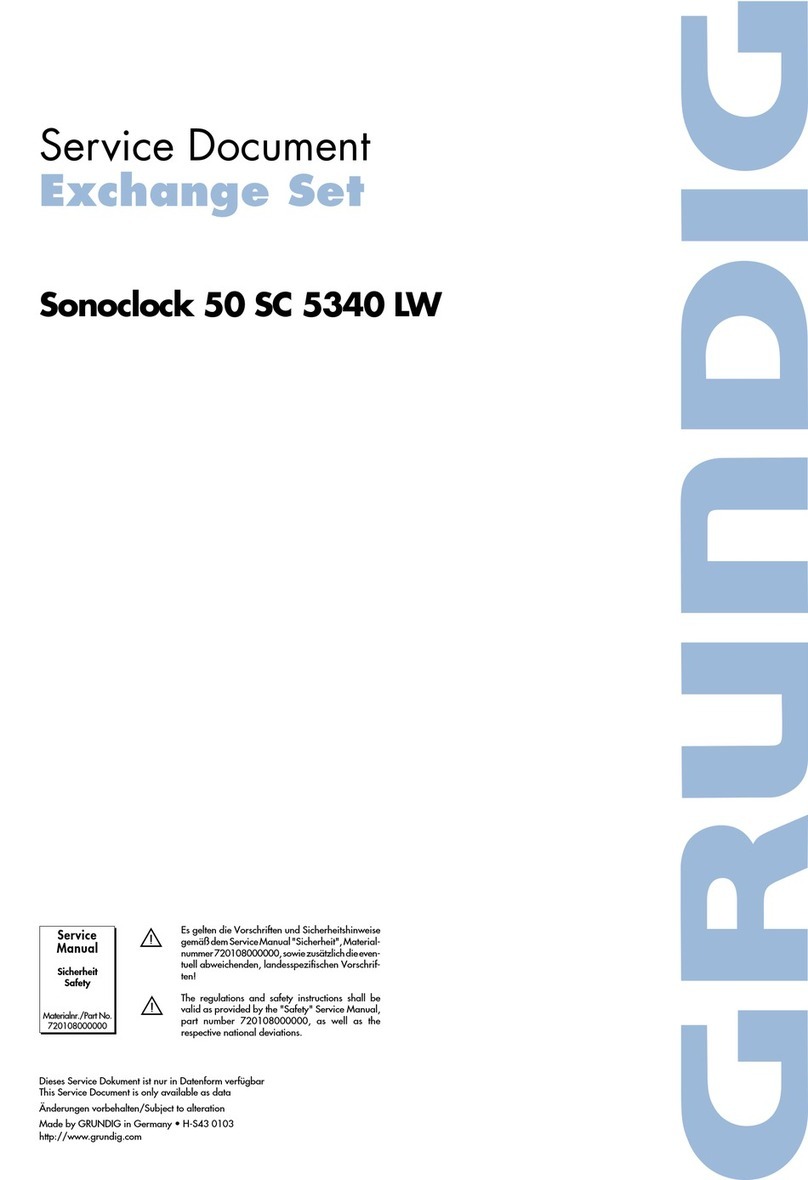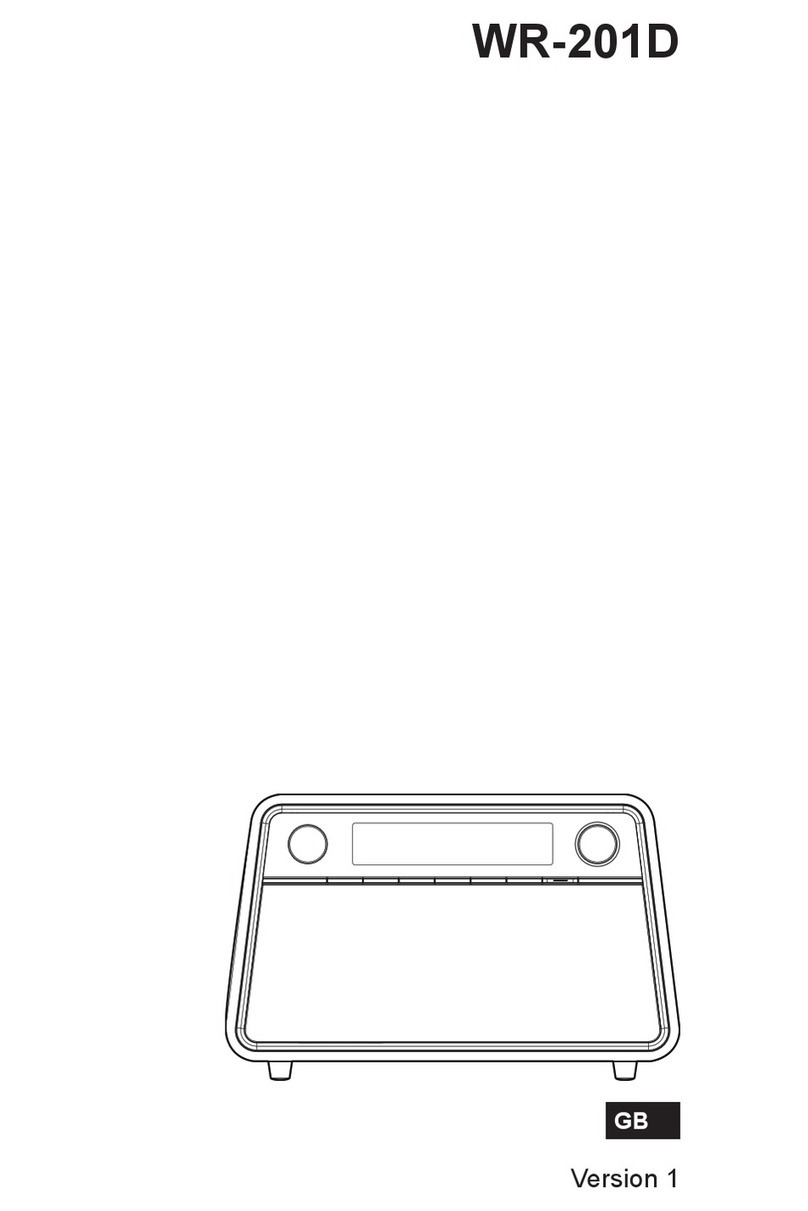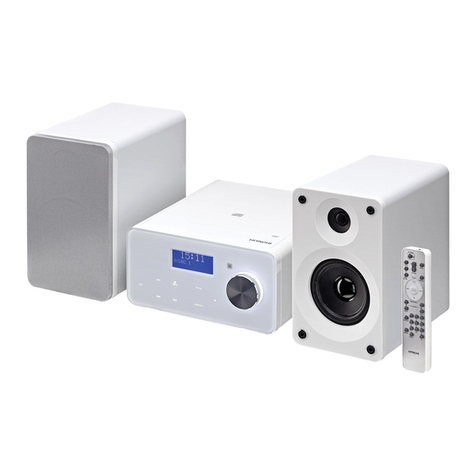RIDGID R84082 User manual

OPERATOR’S MANUAL
JOB-SITE RADIO
MANUEL D’UTILISATION
RADIO DE CHANTIER
MANUAL DEL OPERADOR
RADIO PARA LA OBRA
R84082
BATTERIES AND CHARGERS
SOLD SEPARATELY
BATTERIES ET CHARGEUR
VENDUS SÉPARÉMENT
LAS BATERÍAS Y EL CARGADOR
SE VENDEN POR SEPARADO
Your job-site radio has been engineered and manufactured to our high standards for dependability, ease of operation, and operator
safety. When properly cared for, it will give you years of rugged, trouble-free performance.
WARNING:
To reduce the risk of injury, the user must read and understand the operator’s manual before using this product.
Thank you for buying a RIDGID®product.
SAVE THIS MANUAL FOR FUTURE REFERENCE
To register your RIDGID
product, please visit:
http://register.RIDGID.com
Pour enregistrer votre
produit de RIDGID,
s’il vous plaît la visite:
http://register.RIDGID.com
Para registrar su producto
de RIDGID, por favor visita:
http://register.RIDGID.com
CONSERVER CE MANUEL POUR
FUTURE RÉFÉRENCE GUARDE ESTE MANUAL PARA
FUTURAS CONSULTAS
Cette radio de chantier a été conçue et fabriquée conformément
à nos strictes normes de fiabilité, simplicité d’emploi et sécurité
d’utilisation. Correctement entretenue, elle vous donnera des
années de fonctionnement robuste et sans problème.
AVERTISSEMENT :
Pour réduire les risques de blessures, l’utilisateur doit
lire et veiller à bien comprendre le manuel d’utilisation
avant d’utiliser ce produit.
Merci d’avoir acheté un produit RIDGID®.
Su radio para la obra ha sido diseñada y fabricada de conformidad
con nuestras estrictas normas para brindar fiabilidad, facilidad de
uso y seguridad para el operador. Con el debido cuidado, le brindará
muchos años de sólido y eficiente funcionamiento.
ADVERTENCIA:
Para reducir el riesgo de lesiones, el usuario debe leer
y comprender el manual del operador antes de usar
este producto.
Le agradecemos la compra de un producto RIDGID®.

2 - English
Introduction ...................................................................................................................................................................... 2
Introduction / Introducción
General Safety Rules.....................................................................................................................................................3-4
Règles de sécurité générales / Reglas de seguridad generales
Specific Safety Rules........................................................................................................................................................ 4
Règles de sécurité particulières / Reglas de seguridad específicas
Symbols............................................................................................................................................................................ 5
Symboles / Símbolos
Electrical........................................................................................................................................................................... 6
Caractéristiques électriques / Aspectos eléctricos
Features.........................................................................................................................................................................7-8
Caractéristiques / Características
Assembly.......................................................................................................................................................................... 8
Assemblage / Armado
Operation.....................................................................................................................................................................9-12
Utilisation / Funcionamiento
Maintenance................................................................................................................................................................... 13
Entretien / Mantenimiento
Warranty ......................................................................................................................................................................... 14
Garantie / Garantía
Figure numbers (Illustrations) ....................................................................................................................................15-18
Figure numéros (illustrations) / Figura numeras (ilustraciones)
Parts Ordering and Service ...............................................................................................................................Back Page
Commande de pièces et réparation / Pedidos de piezas y servicio ......................................................... Page arrière / Pág. posterior
TABLE OF CONTENTS
TABLE DES MATIÈRES / ÍNDICE DE CONTENIDO
This product has many features for making its use more pleasant and enjoyable. Safety, performance, and dependability
have been given top priority in the design of this product making it easy to maintain and operate.
* * *
Ce produit offre de nombreuses fonctions destinées à rendre son utilisation plus plaisante et satisfaisante. Lors de la
conception de ce produit, l’accent a été mis sur la sécurité, les performances et la fiabilité, afin d’en faire un outil facile à
utiliser et à entretenir.
* * *
Este producto ofrece numerosas características para hacer más agradable y placentero su uso. En el diseño de este producto
se ha conferido prioridad a la seguridad, el desempeño y la fiabilidad, por lo cual se facilita su manejo y mantenimiento.
INTRODUCTION
INTRODUCTION / INTRODUCCIÓN

3 - English
GENERAL SAFETY RULES
WARNING!
READ THESE INSTRUCTIONS. Failure to follow
all instructions listed below, may result in electric
shock, fire and/or serious personal injury.
KEEP THESE INSTRUCTIONS
HEED ALL WARNINGS
FOLLOW ALL INSTRUCTIONS
WORK AREA
Keep your work area clean and well lit. Cluttered
benches and dark areas invite accidents.
Do not operate products in explosive atmospheres,
such as in the presence of flammable liquids, gases,
or dust. Products create sparks which may ignite the
dust or fumes.
ELECTRICAL SAFETY
A battery operated product with integral batteries or
a separate battery pack must be recharged only with
the specified charger for the battery. A charger that
may be suitable for one type of battery may create a risk
of fire when used with another battery.
Use battery operated product only with specifically
designated battery pack. Use of any other batteries
may create a risk of fire.
Use battery only with charger listed.
PERSONAL SAFETY
Avoid accidental starting. Be sure switch is in the locked
or off position before inserting battery pack. Carrying
products with your finger on the switch or inserting the bat-
tery pack into a product with the switch on invites accidents.
Do not overreach. Keep proper footing and balance
at all times. Proper footing and balance enable better
control of the product in unexpected situations.
Do not use on a ladder or unstable support. Stable
footing on a solid surface enables better control of the
product in unexpected situations.
PRODUCT USE AND CARE
Do not use product if switch does not turn it on or
off. A product that cannot be controlled with the switch
is dangerous and must be repaired.
Disconnect battery pack from product or place the
switch in the locked or off position before making
any adjustments, changing accessories, or storing
the product. Such preventive safety measures reduce
the risk of starting the product accidentally.
When battery pack is not in use, keep it away from
other metal objects like: paper clips, coins, keys, nails,
screws, or other small metal objects that can make
a connection from one terminal to another. Shorting
the battery terminals together may cause sparks, burns,
or a fire.
Keep the radio and its handle dry, clean and free from
oil and grease. Always use a clean cloth when clean-
ing. Never use brake fluids, gasoline, petroleum-based
products, or any strong solvents to clean the radio. Fol-
lowing this rule will reduce the risk of loss of control and
deterioration of the enclosure plastic.
Do not use this apparatus near water.
Clean only with dry cloth.
Do not block any ventilation openings. Install in ac-
cordance with the manufacturer’s instructions.
Do not install near any heat sources such as radiators,
heat registers, stoves, or other apparatus (including
amplifiers) that produce heat.
Only use attachments/accessories specified by the
manufacturer.
SERVICE
Product service must be performed only by qualified
repair personnel. Service or maintenance performed by
unqualified personnel may result in a risk of injury.
IMPORTANT SAFETY INSTRUCTIONS
MODEL LI-ION BATTERY PACK CHARGER
R84082
R84008
R840084 R840091
Do not defeat the safety purpose of the polarized or
grounding-type plug. A polarized plug has two blades
with one wider than the other. A grounding type plug
has two blades and a third grounding prong. The wide
blade or the third prong are provided for your safety. If
the provided plug does not fit into your outlet, consult an
electrician for replacement of the obsolete outlet.
Protect the power cord from being walked on or
pinched particularly at plugs, convenience recepta-
cles, and the point where they exit from the apparatus.
Unplug this apparatus during lightning storms or when
unused for long periods of time.
WARNING: To reduce the risk of fire or electric shock,
this apparatus should not be exposed to rain or moisture
and objects filled with liquids, such as vases, should not
be placed on this apparatus.

4 - English
GENERAL SAFETY RULES
Know your product. Read operator’s manual carefully.
Learn its applications and limitations, as well as the
specific potential hazards related to this product.
Following this rule will reduce the risk of electric shock,
fire, or serious injury.
Battery products do not have to be plugged into
an electrical outlet; therefore, they are always in
operating condition. Be aware of possible hazards
when not using your battery product or when changing
accessories. Following this rule will reduce the risk of
electric shock, fire, or serious personal injury.
Do not place battery products or their batteries near
fire or heat. This will reduce the risk of explosion and
possibly injury.
Do not crush, drop or damage battery pack. Do not
use a battery pack or charger that has been dropped
or received a sharp blow. A damaged battery is subject
to explosion. Properly dispose of a dropped or damaged
battery immediately.
Batteries can explode in the presence of a source
of ignition, such as a pilot light. To reduce the risk of
serious personal injury, never use any cordless product
in the presence of open flame. An exploded battery can
propel debris and chemicals. If exposed, flush with water
immediately.
Do not charge battery product in a damp or wet
location. Following this rule will reduce the risk of electric
shock.
Do not use the radio to listen to music or other audio
programs while operating machinery. Doing so may
cause distractions that could result in serious personal
injury.
This radio is capable of producing sound levels that
can be dangerous to long-term hearing. Listening to
music at high volume for any period of time may cause
noise-induced hearing loss. The higher the volume, the
less time required before your hearing may be affected.
Made for iPod touch®(2nd generation), iPod classic®,
iPod®with video, and iPod nano®(2nd, 3rd, 4th, and
5th generation).
For best results, your battery product should be
charged in a location where the temperature is more
than 50°F but less than 100°F. To reduce the risk of
serious personal injury, do not store outside or in vehicles.
Under extreme usage or temperature conditions,
battery leakage may occur. If liquid comes in contact
with your skin, wash immediately with soap and water.
If liquid gets into your eyes, flush them with clean
water for at least 10 minutes, then seek immediate
medical attention. Following this rule will reduce the risk
of serious personal injury.
To reduce the risk of personal injury and electric
shock, the product should not be played with or
placed where small children can reach it.
To reduce the risk of electric shock, do not expose
to water or rain.
If the power supply cord is damaged, it must be
replaced only by the manufacturer or by an authorized
service center to avoid risk.
Save these instructions. Refer to them frequently and
use them to instruct others who may use this product. If
you loan someone this product, loan them these instruc-
tions also.
IMPORTANT SAFETY INSTRUCTIONS
When servicing a product, use only identical replace-
ment parts. Follow instructions in the Maintenance
section of this manual. Use of unauthorized parts or
failure to follow Maintenance instructions may create a
risk of shock or injury.
Refer all servicing to qualified service personnel.
Servicing is required when the apparatus has been dam-
aged in any way, such as power-supply cord or plug is
damaged, liquid has been spilled or objects have fallen
into the apparatus, the apparatus has been exposed to
rain or moisture, does not operate normally, or has been
dropped.
SPECIFIC SAFETY RULES
CALIFORNIA PROPOSITION 65
WARNING:
This product may contain chemicals, including lead, known to the State of California to cause cancer, birth defects
or other reproductive harm. Wash hands after handling.

5 - English
SYMBOLS
Some of the following symbols may be used on this product. Please study them and learn their meaning. Proper inter-
pretation of these symbols will allow you to operate the product better and safer.
SYMBOL NAME DESIGNATION/EXPLANATION
Safety Alert Indicates a potential personal injury hazard.
Read Operator’s Manual To reduce the risk of injury, user must read and understand opera-
tor’s manual before using this product.
Eye Protection Always wear eye protection with side shields marked to comply
with ANSI Z87.1.
Electric Shock Alert Indicates uninsulated material within the unit that may cause
electrical shock. Do not remove product covering.
Wet Conditions Alert Do not expose to rain or use in damp locations.
Recycle Symbol
This product uses lithium-ion (Li-ion) batteries. Local, state, or
federal laws may prohibit disposal of batteries in ordinary trash.
Consult your local waste authority for information regarding
available recycling and/or disposal options.
V Volts Voltage
A Amperes Current
Hz Hertz Frequency (cycles per second)
W Watt Power
min Minutes Time
Direct Current Type or a characteristic of current
Alternating Current Type of current
Class II Tool Double-insulated construction
The following signal words and meanings are intended to explain the levels of risk associated with this product.
SYMBOL SIGNAL MEANING
DANGER: Indicates an imminently hazardous situation, which, if not avoided, will result
in death or serious injury.
WARNING: Indicates a potentially hazardous situation, which, if not avoided, could result
in death or serious injury.
CAUTION: Indicates a potentially hazardous situation, which, if not avoided, may result in
minor or moderate injury.
CAUTION: (Without Safety Alert Symbol) Indicates a situation that may result in property
damage.
SAVE THESE INSTRUCTIONS

6 - English
DOUBLE INSULATION
Double insulation is a concept in safety in electric products,
which eliminates the need for the usual three-wire grounded
power cord. All exposed metal parts are isolated from the
internal metal motor components with protecting insulation.
Double insulated products do not need to be grounded.
WARNING:
The double insulated system is intended to protect
the user from shock resulting from a break in the
product’s internal wiring. Observe all normal safety
precautions to avoid electrical shock.
NOTE: Servicing of a product with double insulation requires
extreme care and knowledge of the system and should be
performed only by a qualified service technician. For service,
we suggest you return the product to your nearest authorized
service center for repair. Always use original factory replace-
ment parts when servicing.
ELECTRICAL CONNECTION
This product should be connected to a power supply that
is 120 volts, AC only (normal household current), 60 Hz.
Do not operate this product on direct current (DC) through
the power cord. A substantial voltage drop will cause a loss
of power and the motor will overheat. If the product does
not operate when plugged into an outlet, double-check the
power supply.
EXTENSION CORDS
When using a product at a considerable distance from a
power source, be sure to use an extension cord that has
the capacity to handle the current the product will draw. An
undersized cord will cause a drop in line voltage, resulting in
overheating and loss of power. Use the chart to determine
the minimum wire size required in an extension cord. Only
round jacketed cords listed by Underwriter’s Laboratories
(UL) should be used.
When using this product outdoors, use an extension
cord that is designed for outside use. This type of cord is
designated with “WA” or “W” on the cord’s jacket.
Before using any extension cord, inspect it for loose or
exposed wires and cut or worn insulation.
**Ampere rating (on product data plate)
0-2.0 2.1-3.4 3.5-5.0 5.1-7.0 7.1-12.0 12.1-16.0
Cord Length Wire Size (A.W.G.)
25' 16 16 16 16 14 14
50' 16 16 16 14 14 12
100' 16 16 14 12 10 —
**Used on 12 gauge - 20 amp circuit.
NOTE: AWG = American Wire Gauge
WARNING:
Keep the extension cord clear of the working area.
Position the cord so that it will not get caught on
lumber, tools, or other obstructions while you are
working with this product. Failure to do so can
result in serious personal injury.
WARNING:
Check extension cords before each use. If
damaged replace immediately. Never use a
product with a damaged cord since touching
the damaged area could cause electrical shock
resulting in serious injury.
ELECTRICAL

7 - English
FEATURES
PRODUCT SPECIFICATIONS
Operating Temperature:
Normal.......................................................... 32˚F−104˚F
Frequency Ranges:
AM Band................................................520−1710 (kHz)
FM Band.............................................87.5−107.9 (MHz)
Audio Output ...................10 Watts nominal into 4 Ω (Ohm)
Internal Speakers
Power Requirements:
120 V AC, 1 Amp, through cord or 18 V DC through
RIDGID slide-mount batteries
2 AAA (1.5 V DC) batteries for memory/clock backup
1 CR2032 button cell battery for remote control
External Jacks:
Antenna Connector .................. For single-wire antenna
iPod Connector ............ 30-pin iPod docking connector
Input Jack...................................... 3.5 mm (Inside door)
Size .................................... 20 in. x 12 in. x 11 in. (LxHxW)
Weight ..................................................................... 13.9 lb.
WARNING:
Changes or modifications to this unit not expressly
approved by the party responsible for compliance
could void the user’s authority to operate the
equipment.
NOTE: This equipment has been tested and found to comply
with the limits for a Class B digital device, pursuant to Part
15 of the FCC Rules. These limits are designed to provide
reasonable protection against harmful interference in a
residential installation. This equipment generates, uses and
can radiate radio frequency energy and, if not installed and
used in accordance with the instructions, may cause harmful
interference to radio communications.
However, there is no guarantee that interference will not oc-
cur in a particular installation. If this equipment does cause
harmful interference to radio or television reception, which
can be determined by turning the equipment on and off, the
user is encouraged to try to correct the interference by one
or more of the following measures:
Reorient or relocate the receiving antenna.
Increase the separation between the equipment and
receiver.
Connect the equipment into an outlet on a circuit different
from that to which the receiver is connected.
Consult the dealer or an experienced radio/TV technician
for help.
FCC COMPLIANCE
KNOW YOUR JOB-SITE RADIO
See Figures 1 - 2, pages 15 - 16.
The safe use of this product requires an understanding of
the information on the product and in this operator’s manual
as well as a knowledge of the project you are attempting.
Before use of this product, familiarize yourself with all op-
erating features and safety rules.
AC CORD
Your job-site radio can be plugged into an AC power
source.
CORD WRAP
The feet of the radio provide a convenient cord wrap that
can be used during transport.
FOLD-DOWN ROTATABLE FLEXIBLE
ANTENNA
The antenna rotates to help improve reception. The flexible
design prevents damage from bending. It folds down and
out of the way when not in use.
iPod COMPARTMENT
The iPod compartment, located in the drop-down door on
the front of the radio, helps protect your iPod from jobsite
debris. Inside the compartment, there is a 30-pin iPod dock-
ing connector. To charge or play, connect your iPod to the
connector and place the radio in iPod mode.
LCD DISPLAY
The LCD display is clear and visible in all lighting
conditions.
NOTE: The illustrations of the LCD display shown in this
manual are only examples of the frequencies you may see
on your radio and are not the exact frequencies that you
may choose to listen to.
PROTECTIVE FRAME
The radio is mounted with shock absorbers inside a pro-
tective frame to help protect your radio while in use on the
job site. The design of the frame also allows the radio to be
placed on its feet or on either of its sides during play or for
storage.

8 - English
REMOTE CONTROL
The remote control can be used to operate the radio in AM,
FM, iPod, and AUX modes.
FEATURES
SLEEP MODE
To help preserve battery power, the radio will automatically
enter sleep mode approximately 2 hours after it is turned
off. To exit sleep mode and restart the radio, you must use
the ON/OFF/VOLUME knob on the radio. The power but-
ton on the remote control will not power the unit when it is
in sleep mode.
UNPACKING
This product has been shipped completely assembled.
Carefully remove the product and any accessories from
the box. Make sure that all items listed in the packing list
are included.
WARNING:
Do not use this product if it is not completely
assembled or if any parts appear to be missing
or damaged. Use of a product that is not properly
and completely assembled could result in serious
personal injury.
Inspect the product carefully to make sure no breakage
or damage occurred during shipping.
Do not discard the packing material until you have carefully
inspected and satisfactorily operated the product.
If any parts are damaged or missing, please call
1-866-539-1710 for assistance.
PACKING LIST
Job-Site Radio
AAA Batteries (2)
Auxiliary Connection Cable
Remote Control
Button Cell Battery
Operator’s Manual
ASSEMBLY
WARNING:
If any parts are damaged or missing do not operate
this product until the parts are replaced. Use of
this product with damaged or missing parts could
result in serious personal injury.
WARNING:
Do not attempt to modify this product or create
accessories not recommended for use with this
product. Any such alteration or modification is
misuse and could result in a hazardous condition
leading to possible serious personal injury.
WARNING:
To prevent accidental starting that could cause
serious personal injury, always remove the battery
pack from the product when assembling parts.

9 - English
OPERATION
WARNING:
Do not allow familiarity with this product to make
you careless. Remember that a careless fraction of
a second is sufficient to inflict severe injury.
WARNING:
Do not use any attachments or accessories not
recommended by the manufacturer of this product.
The use of attachments or accessories not
recommended can result in serious personal injury.
WARNING:
The job-site radio is not waterproof. To reduce
the risk of fire or electrical shock, do not use near
water. Failure to heed this warning can result in
serious personal injury.
CAUTION:
Always refer to the manual for any device
recommended for use as an attachment or
accessory. Proper use of any device, when attached
to the job-site radio, is the sole responsibility of the
operator. Improper use may damage the device or
the product.
APPLICATIONS
You may use this product for the following purposes:
Listening to AM/FM radio
Listening to iPod and other MP3 players, CD players, and
other audio devices
Charging dockable iPod models
CHARGER AND BATTERY PACKS SOLD
SEPARATELY
This product will accept RIDGID 18 V lithium-ion battery
packs.
For complete charging and battery pack instructions, refer to
the operator’s manuals included with chargers and battery
packs listed in the General Safety Rules for this manual.
NOTE: The radio does not charge battery packs. Battery
packs must be charged in RIDGID brand chargers.
RECEPTION
To decrease interference or electrical noise, reception may
be improved by rotating the antenna or moving the radio to
a higher elevation.
AC CORD
The AC cord can connect the radio to a power supply when
a battery is not available. A dockable iPod can be charged
in the radio when the AC cord or battery pack is in use, but
the battery pack cannot be charged by the radio.
Always turn the radio off before disconnecting it from the
power source.
BATTERY INDICATOR
See Figure 2, page 16.
The battery indicator ( ) appears whenever a battery is
installed in the radio and the power cord is not connected.
If the battery charge is low, the low battery indicator ( )will
flash intermittently.
NOTE: If the AC cord is connected, the battery indicator will
not illuminate even when a battery is installed.
TO INSTALL/REPLACE CLOCK/MEMORY
BATTERIES
See Figure 3, page 17.
It is advisable to write down saved channels before replacing
the clock batteries.
There is a 15-second time frame for replacing the AAA
batteries. If batteries are not replaced within 15 seconds,
the radio will lose all settings previously stored in memory,
and they will require reprogramming.
Always use new alkaline batteries for replacement.
Open the outer cover to the battery compartment located
on the back side of the radio to gain access to the battery
cover door.
Loosen the screw in the battery door. Remove door and
set aside.
Install two new AAA batteries according to polarity
indicators inside the battery compartment.
Replace the battery door and tighten screw to secure.
TO INSTALL/REMOVE BATTERY PACK
See Figure 4, page 17.
To install battery pack:
Open the battery compartment outer cover located on
the back side of the radio.
Place the battery pack in the radio, aligning the raised rib
on the battery pack with the groove in the radio’s battery
port.
Make sure the latches on each side of the battery pack
snap into place and the battery pack is secured to the
radio before beginning operation.
Close the battery compartment outer cover.
NOTE: Leaving the battery pack connected for long periods
of time will drain the battery pack. Always disconnect battery
packs after use.

10 - English
To remove battery pack:
Depress the latches on both sides to release the battery
pack from the radio.
NOTE: Always remove battery pack from radio when not
in use.
TO INSTALL/REPLACE REMOTE CONTROL
BATTERY
See Figure 5, page 17.
Using a coin or flat-head screwdriver in the slot on the
battery door, rotate the door just slightly to the left and
remove.
If replacing an old battery, remove old button cell battery
and discard.
Insert new button cell battery into the compartment with
the positive (+) side facing the door.
NOTE: When replacing, use only CR2032 3V lithium but-
ton cell batteries.
Replace the battery cover and rotate slightly right to
secure.
NOTE: In the locked position, the slot on the battery
compartment door should be straight up and down.
WIRE-STYLE FM ANTENNA (OPTIONAL)
See Figure 6, page 17.
The radio has a connection point for a standard wire-style
antenna for improving indoor FM reception.
For best results, use a simple 1-meter (39.4 in.) length of 22
AWG stranded or solid copper wire. If the wire is insulated,
strip one end to expose at least 1/2 in of the conductor.
NOTE: The wire is not included with this product.
To attach a wire-style antenna, loosen the single screw in
the center of the connector and insert the stripped end of
the antenna wire into one side of the connector. Tighten
the screw.
NOTE: The wire-style antenna works for FM BAND stations
only.
LCD DISPLAY
See Figure 7, page 17.
When the radio is not connected to a power supply, the LCD
display will remain off. If the radio is connected to a power
supply and in the ON position, LEDs will light the display.
You can view the time, frequency, and settings in use on
the LCD display.
NOTE: Always disconnect battery packs after use to prevent
draining the battery pack.
TURNING THE RADIO ON/OFF
See Figure 8, page 17.
Push the ON/OFF/VOLUME knob to turn the radio ON or
OFF.
OPERATION
NOTE: When using DC power only, you may need to keep
the button pressed for up to 3 seconds before the radio
will start. If this happens, replace the radio’s AAA batteries.
ADJUSTING THE VOLUME
See Figure 8, page 17.
To increase the volume: turn the on/off/volume knob ( )
to the right.
To decrease the volume: turn the on/off/volume knob ( )
to the left.
MODE SELECTION
See Figure 9, page 17.
Press the MODE button to display available modes, then use
the left and right arrow keys to highlight the desired mode.
Press Enter ( ) to select the mode.
NOTE: The box around the selected mode will continue to
blink until you press Enter ( ) to confirm your selection.
There are five modes to choose from:
FM mode (includes FM and FM2)
AM mode
iPod: For the 30-PIN dockable iPod connection
AUX: For the 3.5 mm input jack located inside the iPod
compartment
Tools ( ): For adjusting bass and treble, choosing
between stereo and mono, and setting the clock.
NOTE: When turned on, the radio will return to the last
mode that was used if the AC power cord or battery was
not disconnected. In the event all power is lost to the radio,
the display will default to FM mode.
AM/FM TUNING
See Figure 9, page 17.
The left and right arrow buttons and the play/pause button
are used to tune to the desired radio frequency. The selected
frequency is displayed on the LCD.
Press and release the left arrow button to tune to a lower
frequency and press and release the right arrow button
to tune to a higher frequency.
Briefly push either button (not press and hold) to tune one
frequency step at a time.
To SEEK, press and hold desired arrow button for 1 sec-
ond (release when you hear 2 beeps) to tune to the next
frequency with clear reception.
To SCAN, press and hold the Play/Pause button ( )
for 2 seconds (release when you hear 2 beeps) to scan
through all the frequencies with clear reception.
NOTE: When scanning, the radio will stop on frequencies
with clear reception for three seconds before continuing
to the next higher frequency.
Press Enter ( ) to stop scanning and select a frequency.
If no frequency is selected. the radio will return to the
frequency that was displayed when the scan was started.

11 - English
OPERATION
STORING A PRESET IN MEMORY
See Figure 9, page 17.
The memory feature saves frequencies as presets in the
radio’s memory. You can save up to ten frequencies in FM
mode (five in FM and five in FM2) and five frequencies in
AM modes.
To store a frequency in memory:
Tune to the frequency you want to save.
Press and hold any number until you hear 2 beeps.
The memory location will appear on the display under
PRESET.
NOTE: Choosing a memory location where a frequency is
already saved will change the preset to the new frequency.
To recall a preset frequency:
Press the numbered button corresponding to the memory
location number of the saved frequency.
To exit a preset channel and return to Manual Tuning,
press one of the arrow keys.
STEREO/MONO (FM MODE ONLY)
See Figure 10, page 17.
To switch between stereo and mono broadcast:
Press the MODE button until the Tools ( ) menu is
highlighted, then press Enter ( ).
Press either arrow button until the Stereo menu is
highlighted, then press Enter ( ).
Press either arrow button to switch between Stereo and
Mono and press Enter ( ) to store your selection.
STEREO will be displayed on the LCD screen when the radio
is in stereo mode and the selected FM station is broadcasting
in FM stereo.
TONE CONTROL
See Figure 10, page 17.
To adjust the bass and/or treble settings:
Press the MODE button until the Tools ( ) menu is
highlighted, then press Enter ( ).
Press either arrow button until the desired tone (Bass or
Treble) is highlighted, then press Enter ( ).
Press the arrow buttons as desired to add or subtract
bass or treble, then press Enter ( ) to store your
selection.
SETTING THE CLOCK
See Figure 11, page 18.
The time appears on the LCD display when the radio is on. If
the time is flashing on the display, the clock needs to be set.
To set the clock:
Press the MODE button until the Tools ( ) menu is
highlighted, then press Enter ( ).
Press either arrow button until the Clock () menu is
highlighted, then press Enter ( ).
Use the arrow buttons to choose between the 12-hour
and 24-hour clock, then press Enter ( ) to store your
selection.
Use the arrow buttons to set the correct hour, then press
Enter ( ).
NOTE: Pressing and holding the arrow buttons will cause
the numbers to advance more quickly.
Use the arrow buttons to set the correct minutes, then
press Enter ( ) to store your selection.
USING THE REMOTE CONTROL
See Figure 12, page 18.
In most instances, the buttons on the remote control operate
the same as the buttons on the radio itself.
The POWER button ( ) allows you to turn the radio on
and off.
NOTE: If the radio is in sleep mode, the power button
on the remote control will not power the unit. To turn the
radio on, use the ON/OFF/VOLUME knob on the front
of the radio itself.
The MODE button displays available modes, allowing
you to choose between them using the arrow keys on
the remote.
NOTE: The Tools ( ) menu is unavailable from the
remote control. To activate anything within the Tools
menu, you must use the MODE button on the radio.
Use the volume button ( ) to raise and lower the
volume of the radio.
Press and release the left arrow button to tune to a lower
frequency and press and release the right arrow button
to tune to a higher frequency. When using an iPod, this
button will also allow you to move to the previous or next
song in the playlist.
The MUTE button mutes the audio.
In iPod mode, the PLAY ( ) button starts and pauses
the iPod audio.
USING AN iPod/MP3 PLAYER OR CD PLAYER
(NOT INCLUDED) WITH THE JOB-SITE RADIO
See Figures 13 - 15, page 18.
For dockable iPod models (with 30-pin connector):
Made for iPod touch (2nd generation), iPod classic, iPod with
video, and iPod nano (2nd, 3rd, 4th, and 5th generation).
Press the MODE button until the iPod menu is highlighted,
then press Enter ( ).
Open the drop-down compartment door by pulling up on
the latch handle.
Press the tabs on the front of the iPod cradle to lower the
cradle.

12 - English
OPERATION
Remove the cap from the 30-pin connector and place in
the storage area located at the back of the cradle.
Insert the iPod (facing out) into the cradle. Make sure the
30-pin connector on the iPod is aligned with the 30-pin
connector in the cradle and that the iPod is pushed down
completely to ensure proper docking. The iPod should
begin to play automatically.
NOTE: Before inserting the iPod, choose the playlist (or
other group of items such as Album, Song, or Genre) on
the iPod you wish to listen to.
Rotate the adjustment knob at the back of the cradle
left or right as needed just until the face of the knob is
touching the back of the iPod.
NOTE: Overadjusting the knob could cause your iPod to
bend the 30-pin connector out of place. Stop adjusting
the knob as soon as it touches the back of your iPod.
Press the tabs on the front of the iPod cradle until the
cradle clicks back into place.
To protect the iPod from environmental hazards such as
dust, moisture, etc., the drop-down compartment door
must be closed and latched.
Use the buttons on the radio or the remote control to play,
stop, and cycle through your iPod playlist.
The iPod will recharge while docked as long as the radio
is in iPod mode, even when the iPod is playing.
All iPod controls can be used normally while the unit is
docked, with the exception of the volume. Volume is
controlled through the volume control knob on the radio.
Turning the radio off while the iPod is docked WILL NOT
turn the iPod off.
To remove the iPod from the dock, simply lower the cradle
and pull the iPod upward to disconnect.
For complete operating instructions for the iPod, always
refer to the manual that was included with your iPod
model.
For non-docking iPod models, other MP3 players, and
CD players:
Press the MODE button until the AUX menu is highlighted,
then press Enter ( ).
Open the drop-down compartment door by pulling up on
the latch handle.
Make sure the cap is in place on the 30-pin connector.
Place the iPod/MP3 player inside the cradle as described
in the previous section.
NOTE: CD players and some larger MP3 players will not
fit in the cradle. These items can be placed on the foam
padding on the inside of the compartment door. Do not
attempt to close the compartment door when using items
too large to fit in the cradle.
Connect one end of a 3.5 mm audio patch cord (maximum
8 in. long) to the iPod/MP3/CD player.
Connect the other end of the 3.5 mm patch cord to the
AUX jack.
NOTE: Make sure that the audio patch cable is positioned
so that it is not pinched if the door is closed.
The iPod/MP3/CD player must be on and in play mode
for sound to be heard through the speakers.
All iPod/MP3/CD player controls can be used normally
while connected to radio.
NOTE: Volume for any device connected through the
AUX jack can be adjusted using the volume control for
that device or by using the radio’s volume knob.
Turning the radio off will NOT turn the iPod/MP3 player
off.
To protect the iPod/MP3 player from environmental
hazards such as dust, moisture, etc., the drop-down
compartment door must be closed and latched.
NOTE: Some MP3 players will not fit inside the cradle.
In those instances, you will not be able to close the
compartment door.
The AUX jack DOES NOT provide charging function.
For complete operating instructions for all iPod, other
MP3 players, and CD players, always refer to the manual
that was included with your model.

13 - English
MAINTENANCE
WARNING:
When servicing use only identical RIDGID
replacement parts. Use of any other parts may
create a hazard or cause product damage.
WARNING:
To avoid serious personal injury, always remove
the battery pack from the product when cleaning
or performing any maintenance.
GENERAL MAINTENANCE
Avoid using solvents when cleaning plastic parts. Most
plastics are susceptible to damage from various types of
commercial solvents and may be damaged by their use. Use
clean cloths to remove dirt, dust, oil, grease, etc.
WARNING:
Do not at any time let brake fluids, gasoline,
petroleum-based products, penetrating oils, etc.,
come in contact with plastic parts. Chemicals can
damage, weaken or destroy plastic which may
result in serious personal injury.
Only the parts shown on the parts list are intended to be
repaired or replaced by the customer. All other parts should
be replaced at a RIDGID authorized service center.
BATTERY PACK REMOVAL AND PREPARATION
FOR RECYCLING
To preserve natural resources, please
recycle or dispose of batteries properly.
This product uses lithium-ion batteries.
Local, state or federal laws may prohibit
disposal of batteries in ordinary trash.
Consult your local waste authority for information regarding
available recycling and/or disposal options.
WARNING:
Upon removal, cover the battery pack’s terminals
with heavy-duty adhesive tape. Do not attempt to
destroy or disassemble battery pack or remove
any of its components. Lithium-ion and nickel-
cadmium batteries must be recycled or disposed
of properly. Also, never touch both terminals with
metal objects and/or body parts as short circuit
may result. Keep away from children. Failure to
comply with these warnings could result in fire
and/or serious injury.
BATTERIES
This product will accept 18 V lithium-ion batteries. Length
of service from each charging will depend on the type of
work you are doing.
The batteries for this tool have been designed to provide
maximum trouble-free life. However, like all batteries, they
will eventually wear out. Do not disassemble battery pack
and attempt to replace the batteries. Handling of these
batteries, especially when wearing rings and jewelry, could
result in a serious burn.
To obtain the longest possible battery life, we suggest the
following:
Remove the battery pack from the charger once it is fully
charged and ready for use.
For battery pack storage longer than 30 days:
Store the battery pack where the temperature is below
80°F and away from moisture.
Store battery packs in a 30%-50% charged condition.
Every six months of storage, charge the pack as
normal.
iPod, iPod classic, iPod nano, and iPod touch are trademarks of Apple Inc., registered in the U.S. and other countries.
“Made for iPod,” “Made for iPhone,” and “Made for iPad” mean that an electronic accessory has been designed to con-
nect specifically to iPod, iPhone, or iPad, respectively, and has been certified by the developer to meet Apple performance
standards. Apple is not responsible for the operation of this device or its compliance with safety and regulatory standards.
Please note that the use of this accessory with iPod, iPhone, or iPad may affect wireless performance.

14 - English
WARRANTY
Proof of purchase must be presented when requesting war-
ranty service.
Limited to RIDGID®hand held and stationary power tools
purchased 2/1/04 and after. This product is manufactured
by One World Technologies, Inc. The trademark is licensed
from RIDGID, Inc. All warranty communications should be
directed to One World Technologies, Inc., attn: RIDGID Hand
Held and Stationary Power Tool Technical Service at (toll
free) 1-866-539-1710.
90-DAY SATISFACTION GUARANTEE POLICY
During the first 90 days after the date of purchase, if you are
dissatisfied with the performance of this RIDGID®Hand Held
and Stationary Power Tool for any reason you may return
the tool to the dealer from which it was purchased for a full
refund or exchange. To receive a replacement tool you must
present proof of purchase and return all original equipment
packaged with the original product. The replacement tool
will be covered by the limited warranty for the balance of
the 3 YEAR service warranty period.
WHAT IS COVERED UNDER THE 3 YEAR
LIMITED SERVICE WARRANTY
This warranty on RIDGID®Hand Held and Stationary Power
Tools covers all defects in workmanship or materials and nor-
mal wear items such as brushes, chucks, motors, switches,
cords, gears and even cordless batteries in this RIDGID®
tool for three years following the purchase date of the tool.
Warranties for other RIDGID®products may vary.
HOW TO OBTAIN SERVICE
To obtain service for this RIDGID®tool you must return it;
freight prepaid, or take it in to an authorized service center
for RIDGID®branded hand held and stationary power tools.
You may obtain the location of the authorized service center
nearest you by calling (toll free) 1-866-539-1710 or by log-
ging on to the RIDGID®website at www.ridgid.com. When
requesting warranty service, you must present the original
dated sales receipt. The authorized service center will re-
pair any faulty workmanship, and either repair or replace
any part covered under the warranty, at our option, at no
charge to you.
One World Technologies, Inc.
P.O. Box 35, Hwy. 8
Pickens, SC 29671
RIDGID®HAND HELD AND STATIONARY POWER TOOL
3 YEAR LIMITED SERVICE WARRANTY
WHAT IS NOT COVERED
This warranty applies only to the original purchaser at retail
and may not be transferred. This warranty only covers de-
fects arising under normal usage and does not cover any
malfunction, failure or defect resulting from misuse, abuse,
neglect, alteration, modification or repair by other than an
authorized service center for RIDGID®branded hand held
and stationary power tools. Consumable accessories pro-
vided with the tool such as, but not limited to, blades, bits
and sand paper are not covered.
RIDGID, INC. AND ONE WORLD TECHNOLOGIES, INC.
MAKE NO WARRANTIES, REPRESENTATIONS OR
PROMISES AS TO THE QUALITY OR PERFORMANCE OF
ITS POWER TOOLS OTHER THAN THOSE SPECIFICALLY
STATED IN THIS WARRANTY.
ADDITIONAL LIMITATIONS
To the extent permitted by applicable law, all implied warran-
ties, including warranties of MERCHANTABILITY or FITNESS
FOR A PARTICULAR PURPOSE, are disclaimed. Any implied
warranties, including warranties of merchantability or fitness
for a particular purpose, that cannot be disclaimed under
state law are limited to three years from the date of purchase.
One World Technologies, Inc. and RIDGID, Inc. are not
responsible for direct, indirect, incidental or consequential
damages. Some states do not allow limitations on how long
an implied warranty lasts and/or do not allow the exclusion
or limitation of incidental or consequential damages, so the
above limitations may not apply to you. This warranty gives
you specific legal rights, and you may also have other rights
which vary from state to state.

3 - Français
AVERTISSEMENT !
LIRE CES INSTRUCTIONS. Le non-respect de
toutes les instructions ci-dessous peut entraîner un
choc électrique, un incendie et des blessures graves.
CONSERVER CES INSTRUCTIONS
OBSERVER TOUS LES AVERTISSEMENTS
LIRE TOUTES LES INSTRUCTIONS
LIEU DE TRAVAIL
Garder le lieu de travail propre et bien éclairé. Les établis
encombrés et les endroits sombres sont propices aux
accidents.
Ne pas utiliser de produits dans des atmosphères
explosives, en présence de liquides, de gaz ou de
poussières inflammables par exemple. Les produits créent
des étincelles qui pourraient enflammer les poussières ou
les vapeurs.
SÉCURITÉ ÉLECTRIQUE
Les piles du produit, qu’elles soient intégrées ou
amovibles, ne doivent être rechargées qu’avec le
chargeur spécifié. Un chargeur approprié pour un type de
pile peut créer un risque d’incendie s’il est utilisé avec un
autre type de pile.
Utiliser le produit exclusivement avec le bloc de piles
indiqué. L’usage de tout autre bloc peut créer un risque
d’incendie.
Ne recharger les piles qu’avec l’appareil indiqué.
SÉCURITÉ PERSONNELLE
Éviter les démarrages accidentels. S’assurer que le
commutateur est verrouillé en position d’arrêt avant
d’insérer le bloc de piles. Le transport de produits avec le
doigt sur le commutateur ou l’insertion du bloc de pile avec
le commutateur en position de marche est une invite aux
accidents.
Ne pas travailler hors de portée. Toujours se tenir bien
campé et en équilibre. Une bonne tenue et un bon équilibre
permettent de mieux contrôler le produit en cas de situation
imprévue.
Ne pas utiliser l’produit sur une échelle ou un support
instable. Une bonne tenue et un bon équilibre permettent
de mieux contrôler le produit en cas de situation imprévue.
UTILISATION ET ENTRETIEN DU PRODUIT
Ne pas utiliser le produit si le commutateur ne permet pas
de le mettre en marche et de l’arrêter. Un produit qui ne
peut pas être contrôlé par son commutateur est dangereux
et doit être réparé.
Déconnecter le bloc de piles du produit et mettre le
commutateur en position d’arrêt ou de verrouillage avant
d’effectuer des réglages, de changer d’accessoire ou de
remiser le produit.Ces mesures de sécurité réduisent les
risques de démarrage accidentel du produit.
Lorsque le bloc de piles n’est pas en usage, le tenir
à l’écart d’articles métalliques tels que : attaches
trombones, pièces de monnaie, clous, vis et autres petits
objets métalliques risquant d’établir le contact entre les
deux bornes. La mise en court-circuit des bornes d’une pile
peut entraîner des étincelles, des brûlures ou un incendie.
Garder la radio et sa poignée sèches, propres et
exemptes d’huile ou de graisse. Toujours utiliser un chiffon
propre pour le nettoyage. Ne jamais utiliser de liquide de
freins, d’essence ou de produits à base de pétrole pour
nettoyer la radio. Le respect de cette consigne réduira les
risques de perte de contrôle et d’endommagement du boîtier
en plastique.
Ne pas utiliser cet appareil près d’eau.
Ne nettoyer l’appareil qu’avec un chiffon sec.
Ne pas bloquer les ouïes d’aération. Installer l’appareil
conformément aux instructions du fabricant.
Ne pas installer l’appareil près de sources de chaleur
telles que radiateurs, bouches de chaleurs, poêles ni
d’autres appareils (y compris les amplificateurs) qui
produisent de la chaleur.
Utiliser uniquement les raccords ou les accessoires
spécifiés par le fabricant.
DÉPANNAGE
L’entretien de l’produit doit être réalisé uniquement
par un personnel de réparation qualifié. Les réparations
ou entretiens effectués par des personnes non qualifiées
présentent des risques de blessures.
CONSIGNES DE SÉCURITÉ IMPORTANTES
RÈGLES DE SÉCURITÉ GÉNÉRALES
MODÈLE BLOC-PILES CHARGEUR
R84082
R84008
R840084 R840091
Ne pas neutraliser la fonction de sécurité de la fiche
polarisée ou du type mise à la terre. Une fiche polarisée a
deux lames, dont l’une est plus large que l’autre. Une fiche
du type mise à la terre a elle aussi deux lames, en plus d’une
broche de mise à la terre. La lame la plus large et la broche
ont pour but d’assurer la sécurité. Si la fiche fournie ne se
branche pas dans la prise, demander à un électricien de
remplacer la prise désuète.
Protéger le cordon d’alimentation pour que personne ne
marche dessus ou ne le pince, en particulier au niveau
des fiches, des prises de courant et des points où il sort
de l’appareil.
Débrancher cet appareil pendant les orages électriques
ou en cas d’inutilisation prolongée.
AVERTISSEMENT : Afin de réduire le risque d’incendie ou
de choc électrique, ne pas exposer cette radio à la pluie ou
à l’humidité. Les objets contenant du liquide, tels que des
vases, ne devraient pas être déposés sur cet appareil.

4 - Français
RÈGLES DE SÉCURITÉ PARTICULIÈRES
Bien connaître le produit. Lire attentivement le manuel
d’utilisation. Apprendre les applications et les limites
du produit, et connaître les dangers spécifiques relatifs
à son utilisation. Le respect de cette consigne réduira
les risques d’incendie, de choc électrique et de blessures
graves.
Les produits fonctionnant sur piles n’ayant pas besoin
d’être branchés sur une prise secteur sont toujours en
état de utilisation. Tenir compte des dangers possibles
lorsque le produit fonctionnant sur pile n’est pas utilisé et
lors du remplacement d’accessoires. Le respect de cette
consigne réduit les risques d’incendie, de choc électrique
et de blessures graves.
Ne pas placer un produit fonctionnant sur pile ou sa pile
à proximité de flammes ou d’une source de chaleur. Ceci
réduira les risques d’explosion et de blessures.
Ne pas écraser, faire tomber ou endommager le bloc
de piles. Ne pas utiliser un bloc de piles ou un chargeur
endommagé ou soumis à un choc violent. Une pile
endommagée risque d’exploser. Éliminer immédiatement
toute pile endommagée, selon une méthode appropriée.
Les piles peuvent exploser en présence d’une source
d’inflammation, telle qu’une veilleuse. Pour réduire les
risques de blessures graves, ne jamais utiliser un appareil
sans fil, quel qu’il soit, en présence d’une flamme vive. En
explosant, une pile peut projeter des débris et des produits
chimiques. En cas d’exposition, rincer immédiatement les
parties atteintes avec de l’eau.
Ne pas recharger un produit fonctionnant sur pile dans
un endroit humide ou mouillé. Le respect de cette règle
réduira les risques de choc électrique.
Ne pas utiliser l’appareil radio pour écouter de la musique
ou d’autres émissions audio au moment d’opérer de la
machinerie. Ne pas respecter cette directive peut causer
des distractions qui pourraient entraîner des blessures
graves.
Cet appareil radio est suffisamment puissant pour
endommager l’ouïe à long terme. L’écoute de la musique
à un niveau sonore élevé pendant une certaine période
peut entraîner une perte auditive attribuable au bruit. Plus
le niveau sonore est élevé, moins il faudra de temps pour
endommager l’ouïe.
Conçu pour l’iPod touch®(2e génération), iPod classic®,
iPod®avec mode vidéo, et iPod nano®(2e, 3e, 4e , et 5e
générations).
Pour un résultat optimal, recharger le produit fonctionnant
sur pile dans un local où la température est comprise
entre 10 et 38 °C (50 et 100 °F). Ne pas ranger le produit
à l’extérieur ou dans un véhicule, afin de réduire le risque
de blessures graves.
Si le produit est utilisé de façon intensive ou sous des
températures extrêmes, des fuites de pile peuvent se
produire. En cas de contact du liquide avec la peau,
rincer immédiatement la partie atteinte avec de l’eau
savonneuse. En cas de projection dans les yeux, les
rincer à l’eau fraîche pendant au moins 10 minutes, puis
contacter immédiatement un médecin. Le respect de cette
consigne réduira les risques de blessures graves.
Pour réduire le risque de blessures et de choc électrique,
ne pas utiliser ni placer ce produit à la portée d’enfants
en bas âge.
Pour réduire le risque de choc électrique, ne pas exposer
à l’eau ou à la pluie.
Si le cordon d’alimentation est endommagé, il doit être
remplacé uniquement pas le fabricant ou par un centre de
réparation agréé pour éviter tout risque.
Conserver ces instructions. Les consulter fréquemment
et les utiliser pour instruire les autres utilisateurs éventuels.
Si cet produit est prêté, il doit être accompagné de ces
instructions.
CONSIGNES DE SÉCURITÉ IMPORTANTES
RÈGLES DE SÉCURITÉ GÉNÉRALES
Utiliser exclusivement des pièces identiques à celles
d’origine pour les réparations. Se conformer aux
instructions de la section Entretien de ce manuel.
L’usage de pièces non autorisées ou le non-respect des
instructions peut présenter des risques de choc électrique
ou de blessures.
Faire effectuer toutes les réparations par un personnel
d’entretien qualifié. Il est nécessaire de faire réparer
l’appareil lorsqu’il a subi des dommages quelconques ; si, par
exemple, le cordon d’alimentation ou la fiche est endommagé,
si du liquide a été renversé ou si des objets sont tombés dans
l’appareil, si celui-ci a été exposé à la pluie ou à l’humidité,
s’il ne fonctionne pas normalement ou s’il a chuté.
PROPOSITION 65 DE LA CALIFORNIE
AVERTISSEMENT :
Ce produit peut contenir des produits chimiques, notamment du plomb, identifiés par l’état de Californie comme causes
de cancer, de malformations congénitales et d’autres troubles de l’appareil reproducteur. Bien se laver les mains après
toute manipulation.

5 - Français
CONSERVER CES INSTRUCTIONS
SYMBOLES
Certains des symboles ci-dessous peuvent être utilisés sur l’produit. Veiller à les étudier et à apprendre leur signification.
Une interprétation correcte de ces symboles permettra d’utiliser l’produit plus efficacement et de réduire les risques.
SYMBOLE NOM DÉSIGNATION / EXPLICATION
Symbole d’alerte de sécurité Indique un risque de blessure potentiel.
Lire le manuel d’utilisation
Toujours porter des lunettes de sécurité munies d’écrans latéraux
et un masque facial intégral lors de l’utilisation de cet outil.
Protection oculaire Toujours porter une protection oculaire avec écrans latéraux
certifiée conforme à la norme ANSI Z87.1.
Avertissement de choc
électrique
Indique la présence de matériaux non isolés à l’intérieur de l’unité
qui peuvent provoquer des chocs électriques. Ne pas retirer le
couvercle du produit.
Avertissement concernant
l’humidité Ne pas exposer à la pluie ou l’humidité.
Symboles de recyclage
Ce produit utilise les piles lithium-ion (Li-ion). Les réglementations
locales ou gouvernementales peuvent interdire de jeter les piles
dans les ordures ménagères. Consulter les autorités locales
compétentes pour les options de recyclage et/ou l’élimination.
V Volts Tension
A Ampères Intensité
Hz Hertz Fréquence (cycles par seconde)
W Watt Alimentation
min Minutes Temps
Courant continu Type ou caractéristique du courant
Courant alternatif Type de courant
Outil de la classe II Construction à double isolation
Les termes de mise en garde suivants et leur signification ont pour but d’expliquer le niveau de risques associés à
l’utilisation de ce produit.
SYMBOLE SIGNAL SIGNIFICATION
DANGER : Indique une situation extrêmement dangereuse qui, si elle n’est pas évitée,
causera des blessures graves ou mortelles.
AVERTISSEMENT : Indique une situation potentiellement dangereuse qui, si elle n’est pas
évitée, peut causer des blessures graves ou mortelles.
ATTENTION : Indique une situation potentiellement dangereuse qui, si elle n’est pas
évitée, peut causer des blessures légères ou de gravité modérée.
ATTENTION : (Sans symbole d’alerte de sécurité) Indique une situation pouvant causer
des dommages matériels.

6 - Français
DOUBLE ISOLATION
La double isolation est un dispositif de sécurité utilisé sur les
produits à moteur électriques, éliminant le besoin de cordon
d’alimentation habituel à trois fils avec terre. Toutes les
pièces métalliques exposées sont isolées des composants
internes du moteur par l’isolation protectrice. Les produits à
double isolation ne nécessitent pas de mise à la terre.
AVERTISSEMENT :
Le système à double isolation est conçu pour
protéger l’utilisateur contre les chocs électriques
causés par une rupture du câblage interne de
l’produit. Prendre toutes les précautions de sécurité
normales pour éviter les chocs électriques.
NOTE : La réparation d’un produit à double isolation exigeant
des précautions extrêmes ainsi que la connaissance du
système, elle ne doit être confiée qu’à un réparateur qualifié.
En ce qui concerne les réparations, nous recommandons
de confier l’produit au centre de réparation le plus proche.
Utiliser exclusivement des pièces d’origine pour les
réparations.
CONNEXIONS ÉLECTRIQUES
Il doit être branché uniquement sur une alimentation 120 V,
60 Hz, c.a. (courant résidentiel standard). Ne pas l’utiliser
sur une source de courant continu (c.c.) en le reliant par le
cordon d’alimentation. Une chute de tension importante
causerait une perte de puissance et une surchauffe du
moteur. Si l’produit ne fonctionne pas une fois branché,
vérifier l’alimentation électrique.
CORDONS PROLONGATEURS
Lors de l’utilisation d’un outil électrique à grande distance
d’une prise secteur, veiller à utiliser un cordon prolongateur
d’une capacité suffisante pour supporter l’appel de courant
de l’produit. Un cordon de capacité insuffisante causerait
une baisse de la tension de ligne, entraînant une perte
de puissance et une surchauffe. Se reporter au tableau
ci-dessous pour déterminer le calibre minimum de fil requis
pour un cordon donné. Utiliser exclusivement des cordons à
gaine cylindrique homologués par Underwriter’s Laboratories
(UL).
Pour le travail à l’extérieur, utiliser un cordon prolongateur
spécialement conçu à cet effet. Ce type de cordon porte
l’inscription « WA » ou « W » sur sa gaine.
Avant d’utiliser un cordon prolongateur, vérifier que ses fils
ne sont ni détachés ni exposés et que son isolation n’est ni
coupée, ni usée.
**Intensité nominale (sur la plaquette signalétique de l’produit)
0-2,0 2,1-3,4 3,5-5,0 5,1-7,0 7,1-12,0 12,1-16,0
Longueur du Calibre de fil
cordon (A.W.G.)
25' 16 16 16 16 14 14
50' 16 16 16 14 14 12
100’ 16 16 14 12 10
**Utilisé sur circuit de calibre 12 – 20 A
NOTE : AWG = American Wire Gauge
AVERTISSEMENT :
Maintenir le cordon prolongateur à l’écart de la
zone de travail. Lors du travail avec un cordon
électrique, placer le cordon de manière à ce qu’il ne
risque pas de se prendre dans les pièces de bois,
produits et autres obstacles. Ne pas prendre cette
précaution peut entraîner des blessures graves.
AVERTISSEMENT :
Vérifier l’état des cordons prolongateurs avant
chaque utilisation. Remplacer immédiatement tout
cordon endommagé. Ne jamais utiliser un produit
dont le cordon d’alimentation est endommagé,
car tout contact avec la partie endommagée
pourrait causer un choc électrique et des blessures
graves.
CARACTÉRISTIQUES ÉLECTRIQUES

7 - Français
CARACTÉRISTIQUES
FICHE TECHNIQUE
Température normale de service :
Normal ............................... 0 ˚C – 104 ˚C (32 ˚F – 104 ˚F)
Plage de fréquences :
Bande AM.............................................520 – 1710 (kHz)
Bande FM ......................................... 87,5 – 107,9 (MHz)
Sortie audio ...................10 W de courant nominal dans les
haut-parleurs internes comprenant 4 Ω(Ohm)
Alimentation :
120 V c.a., 1 A, avec le cordon d’alimentation ou 18 V
c.c. avec les piles amovibles RIDGID.
2 piles AAA (1,5 V c.c.) pour assurer le UTILISATION de
la mémoire et de l’horloge
1 pile bouton CR2032 pour la télécommande
Connecteur femelle :
Connecteur de l’antenne .........pour une antenne à un fil
Connecteur pour iPod ..........................Connecteur à 30
à 30 broches pour iPod
Connecteur femelle...... 3,5 mm (à l’intérieur de la porte)
Dimension.............................................. 508 mm (20 po) (L)
x 304,8 mm (12 po) (H)
× 279,4 mm (11 po) (W)
Poids ............................................................6,3 kg (13,9 lb)
AVERTISSEMENT :
Toute modification apportée à l’unité qui n’a pas
été expressément approuvée par le responsable
de la conformité du produit pourrait suffire à
révoquer le droit de l’utilisateur à se servir de
l’équipement.
NOTE : Après avoir fait subir un essai à l’équipement, il a été
déterminé que celui-ci est conforme aux normes relatives
à un appareil numérique de classe B, selon la partie 15 des
règles de la FCC. Ces normes ont été fixées afin de fournir
une protection raisonnable contre une interférence nuisible
dans une installation résidentielle. Cet équipement produit
et utilise de l’énergie RF. Si l’équipement n’est pas installé
et utilisé conformément aux instructions, cela peut causer
de l’interférence aux radiocommunications.
Toutefois, des interférences peuvent se produire dans une
installation donnée. Si cet équipement ne produit aucun
brouillage préjudiciable à la réception des signaux de radio
ou de télévision, ce qui peut être déterminé en allumant et en
éteignant l’appareil, on recommande à l’utilisateur de corriger
l’interférence par l’une des mesures suivantes :
Réorienter ou déplacer l’antenne de réception.
Augmenter l’espacement entre l’équipement et le
récepteur.
Brancher l’équipement dans une prise différente de celle
du récepteur.
Consulter le marchand ou un technicien expérimenté en
radiotélédiffusion pour obtenir de l’aide.
CONFORMITÉ AUX NORMES DE LA FEDERAL
COMMUNICATIONS COMMISSION (FCC)
APPRENDRE À BIEN CONNAÎTRE LA RADIO
DE CHANTIER
Voir les figures 1 et 2, pages 15 et 16.
L’utilisation sécuritaire de ce produit exige une compréhension
des renseignements figurant sur l’produit et contenus dans
le manuel d’utilisation, ainsi qu’une bonne connaissance du
projet entrepris. Avant d’utiliser ce produit, se familiariser
avec toutes ses caractéristiques et règles de sécurité.
CORDON D’ALIMENTATION c.a.
Il est possible de brancher la radio de chantier dans une
source d’alimentation c.a.
REMBOBINEUR DE CORDON
Les pieds de la radio offrent un rembobineur pratique pour
le transport.
ANTENNE RABATTABLE, FLEXIBLE ET
ORIENTABLE
Il est possible de faire pivoter l’antenne pour obtenir une
meilleure réception. L’antenne est flexible, ce qui la protège
contre les dommages lorsqu’elle est pliée. Il est possible de
la rabattre sur le côté lorsqu’elle n’est pas utilisée.
COMPARTIMENT POUR iPod
Situé à l’intérieur de la porte rabattable, sur la face avant
de la radio, le compartiment pour iPod protège l’appareil
des débris du lieu de travail. Le compartiment comprend un
connecteur à 30 broches pour iPod avec station d’accueil.
Pour charger ou utiliser, brancher l’iPod au connecteur et
régler la radio en mode iPod.
AFFICHEUR ACL
L’afficheur ACL est clair et visible dans toutes les conditions
d’éclairage.

8 - Français
NOTE : Les images de l’afficheur ACL présentées dans le
manuel d’utilisation constituent seulement des exemples de
fréquences qu’il est possible de voir sur la radio. Il ne s’agit
pas de fréquences exactes qu’il est possible de syntoniser.
CADRE DE PROTECTION
La radio est montée sur amortisseurs de choc à l’intérieur
d’un cadre de protection afin d’être protégée pendant son
utilisation sur le lieu de travail. La conception du cadre
permet également de placer la radio sur ses pieds ou sur le
côté pendant son utilisation ou pour son rangement.
CARACTÉRISTIQUES
TÉLÉCOMMANDE
Il est possible d’utiliser la télécommande pour régler la radio
en mode AM, FM, iPod et AUX.
MODE DE VEILLE
Pour aider à conserver l’énergie de la pile, la radio se met
automatiquement en mode de veille environ 2 heures après
sa mise hors tension. Pour sortir du mode de veille et
remettre la radio en marche, il faut utiliser le bouton ON/
OFF/VOLUME de la radio. La mise en marche de la radio en
mode de veille ne peut se faire avec le bouton d’alimentation
de la télécommande.
DÉBALLAGE
Ce produit a été expédié complètement assemblé.
Avec précaution, sortir l’produit et les accessoires de
la boîte. S’assurer que toutes les pièces figurant sur la
liste de contrôle sont incluses.
AVERTISSEMENT :
Ne pas utiliser le produit s’il n’est pas complètement
assemblé ou si des pièces semblent manquantes
ou endommagées. Le fait d’utiliser un produit
assemblé de façon inadéquate ou incomplète peut
entraîner des blessures graves.
Examiner soigneusement l’produit pour s’assurer que rien
n’a été brisé ou endommagé en cours de transport.
Ne pas jeter les matériaux d’emballage avant d’avoir
soigneusement examiné l’produit et avoir vérifié qu’il
fonctionne correctement.
Si des pièces manquent ou sont endommagées,
téléphoner au 1-866-539-1710.
LISTE DE CONTRÔLE D’EXPÉDITION
Radio de chantier
Piles AAA (2)
Câble de raccordement auxiliaire
Télécommande
Pile bouton
Manuel d’utilisation
ASSEMBLAGE
AVERTISSEMENT :
Si des pièces manquent ou sont endommagées,
ne pas utiliser cet produit avant qu’elles aient été
remplacées. Le fait d’utiliser ce produit même
s’il contient des pièces endommagées ou s’il lui
manque des pièces peut entraîner des blessures
graves.
AVERTISSEMENT :
Ne pas essayer de modifier cet produit ou de
créer des accessoires non recommandés pour cet
produit. De telles altérations ou modifications sont
considérées comme un usage abusif et peuvent
créer des conditions dangereuses, risquant
d’entraîner des blessures graves.
AVERTISSEMENT :
Pour empêcher un démarrage accidentel pouvant
entraîner des blessures graves, tojours retirer
le bloc de pile de l’produit avant d’assembler
des pièces.
Table of contents
Languages:
Other RIDGID Radio manuals

RIDGID
RIDGID R84083 User manual

RIDGID
RIDGID 019670004701 User manual

RIDGID
RIDGID R84087ID User manual
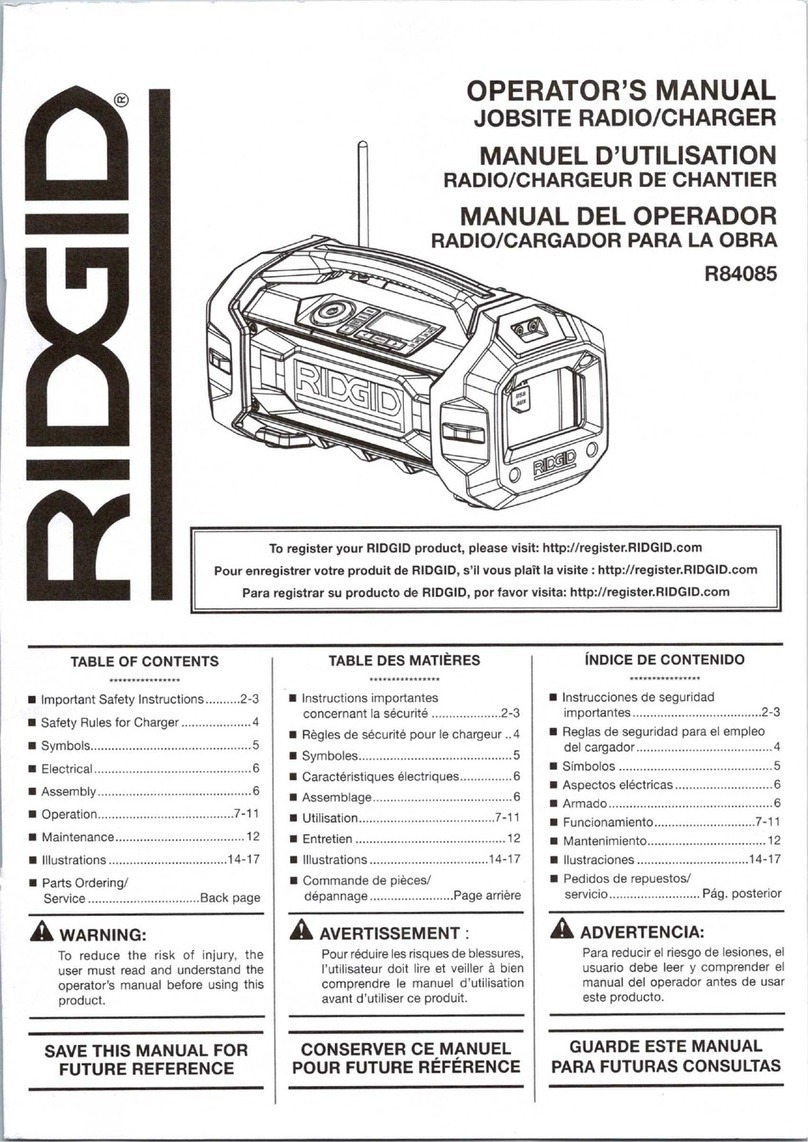
RIDGID
RIDGID R84085 User manual
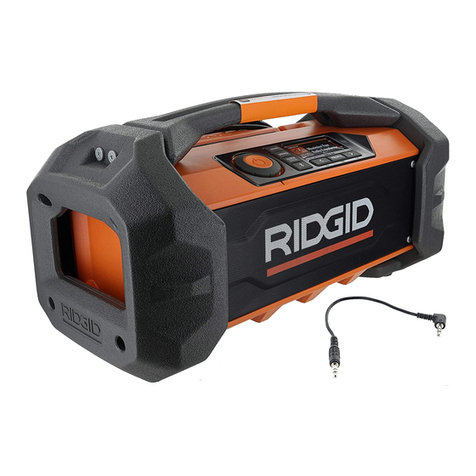
RIDGID
RIDGID R84087 User manual

RIDGID
RIDGID R84081 User manual

RIDGID
RIDGID 019670003 User manual

RIDGID
RIDGID R84089 User manual

RIDGID
RIDGID R84087 User manual
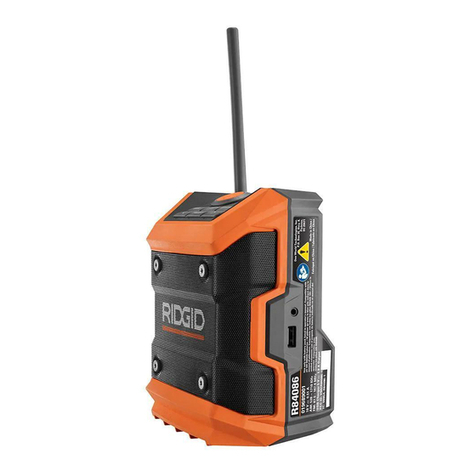
RIDGID
RIDGID R84086 User manual
